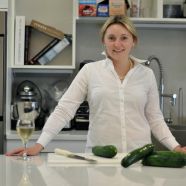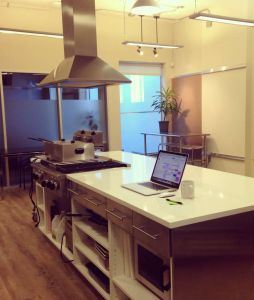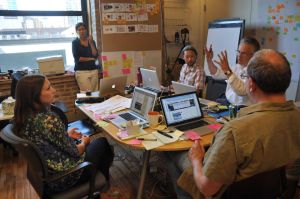Welcome to My Kitchen: What It Means to Design Food and Beverage
I have strong memories, perhaps even dreams, of tasting something new and exciting. As a child this is the greatest feeling imaginable. An ice cream cone that you were allowed to have on a long drive to the cabin, popcorn you shared with your brother while staying up late waiting for Santa, and even that first taste of white wine with your mother when you were home for spring break. Many memories we have can be tied to food and beverage, so when we find something new and seemingly magical, we often wonder where it came from.
Picture yourself stopping in a corner store when something catches your eye. From afar it looks like sweet tea, but not just any old sweet tea—this one seems different, so you decide to give it a try. The partially frozen texture flowing through the popup straw piques your interest and the sugary tea, with just a hint of sour Meyer lemon, makes your mouth water. All at once, it is a completely new experience yet comfortingly familiar, reminding you of your grandmother’s recipe but in a novel and unique form. Going about your day you might stop and think, “I wonder who created that?”
You might be surprised to know that many companies hire innovation consultants to generate original recipes for food and beverages. In fact, I work in Chicago as a culinary designer at one such consultancy, gravitytank, a research and design firm that creates new services and products. My job is to develop and test tasty concoctions that may end up in your fridge or on your table. If you have ever wondered, “Who came up with this delicious recipe?” please, join me for an inside look at my office, the prototyping kitchen.
Starting with People
We begin every project with clients and consumers. A client comes to us with a problem, an idea, or an opportunity. Our teams comprise strategists, researchers, and designers who work together to achieve the same goal: finding and creating a solution to these clients and consumer needs.
In the case of that sweet tea I mentioned, imagine that a beverage company came to us believing that there is great opportunity in creating and bottling an authentic sweet tea for their Southern audience. Knowing that this does not currently exist, we question why that is the case and then seek to understand connections to the South and the cultural nuances that differ from our frame of reference in the Midwest. We look at consumer joys and pains. We ask what excites people in the beverage cooler as well as what may be causing difficulty. Perhaps these victories and concerns are focused around convenience and packaging, flavor and texture, or maybe health and ingredients. We use these questions and begin to think about potential opportunity areas, and we try to understand how they connect while we start to generate hypotheses. We gather this information, look at comparable brands and products, and go straight to people like you. We spend time with consumers to learn about their lives, families, values and struggles, and successes.
By understanding trends and embracing the day-to-day reality of the consumers’ lives, gravitytank develops new insights that spark the brainstorming process. We dream up hundreds of ideas; some look ridiculous and some just plain impossible, but we push ourselves in new and exciting directions. Once our team has a rough idea of the concepts we are excited about, I roll up my sleeves, tie on my apron, head to the kitchen, and bring them to life.
Make to Learn
My office is a kitchen, and in this kitchen, experimentation rules. We make to learn and learn to make, prisoner to no equipment, ingredient, or thought. No matter how wacky an idea about a new food or beverage product may be, part of my job is to make the concept an edible reality for colleagues, clients, and research participants.
Before joining gravitytank, I worked at creative food-related companies where at times I felt that the product’s storyline or presentation trumped taste. In those worlds, creativity was often sacrificed to monetize a task. Here, in this kitchen, experimentation and discovery drive design and delivery.
If working on the sweet tea project, I would use everything from age-old recipes and premade mixes to create dozens of different types of sweet tea, constantly sampling, sipping, improving, and adjusting. I might play around with snow cone machines, ice molding, or freeze-drying. One version could come from my grandmother’s 1973 recipe for sweet tea punch, which originated from a Junior League cookbook, while another started from powdered iced tea mix. My colleagues, as you might imagine, frequently serve as eager testers and sounding boards. They provide valuable feedback to help improve products and ensure that they deliver on consumer expectations, stand out in a crowd, and taste fantastic.
If we were ready to test this new sweet tea recipe beyond our walls, we would enter the concept labs stage. We would recruit a small sample of the target consumers and carefully select a number of participants. We would meet the participants, engage in conversation and make them comfortable, letting them know that they are part of our team. Their comments might range from approval to utter disgust, but all of their reactions would be helpful.
Testing is less about getting a “yes” or “no” than about shades of opinion and understanding. When talking with consumers, our team and clients can witness their instant reactions, see their facial expressions, and hear their critique or praise in the moment. Perhaps one sweet tea recipe is too cold, jolting participants with brain freezes. Another could be a bit too thick, maybe too sweet, or not sweet enough. We learn about when and where people buy particular versions, how much they might pay, how often they would drink it, and why. Perhaps we’ll discuss brand: who should sell it, and where? With this information, we would be able to regroup and move the concept even further along by changing or adapting based on this feedback.
Iterating for Innovation
The next phase in the process is discussion, debate, and the refinement or adaptation of concepts and products. Team members have individual responsibilities including strategizing, creating business models, understanding the scale of the product, analyzing the consumer insights from research, communication, interaction, and designing products.
As a chef, I typically head back to the kitchen to work on recipe after recipe, batch after batch, slowly but surely narrowing in on “the one.” For the imaginary tea project, we might strengthen the amount of mint, add texture to the tea, or repackage it. Through weeks of this exploratory process that continuously changes and adapts, our team ultimately lands on a solution, and in the end there is a single product. An answer to the question, a bright new idea, something for the client to take, make, and market, and for you to try!
I have gained empathy for all the different work streams that go into developing a product, the risks involved in capitalizing on a trend, the pressure that follows expanding a brand, work that goes into the business models and product roadmaps, and the risks and rewards associated with design based on a gut feeling or belief. It is amazing to watch it all come together; it is exhilarating, and I love it.
I cook for people of all ages, races, genders, cultures, and regions, which is what I believe food is all about. I spend my days working with colleagues in our open office and in the kitchen experimenting with food. It may not be rocket science, but in a unique and extraordinary way, gravitytank creates new products, services, and systems in response to what people need and want, ultimately finding new ways to push the limits of joy and reach you in an unexpected and wonderful way, perhaps on a hot August morning, through a tantalizing sweet tea unlike any you’ve ever tasted.










Awesome article!! Gravitytank seems like an awesome place to work and you seem like the perfect person for the job!!